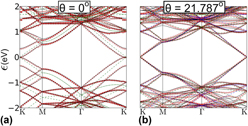Crossref Citations
This article has been cited by the following publications. This list is generated based on data provided by
Crossref.
Naik, Mit H.
and
Jain, Manish
2017.
Origin of layer dependence in band structures of two-dimensional materials.
Physical Review B,
Vol. 95,
Issue. 16,
Thygesen, Kristian Sommer
2017.
Calculating excitons, plasmons, and quasiparticles in 2D materials and van der Waals heterostructures.
2D Materials,
Vol. 4,
Issue. 2,
p.
022004.
Cancès, Eric
Cazeaux, Paul
and
Luskin, Mitchell
2017.
Generalized Kubo formulas for the transport properties of incommensurate 2D atomic heterostructures.
Journal of Mathematical Physics,
Vol. 58,
Issue. 6,
Massatt, Daniel
Luskin, Mitchell
and
Ortner, Christoph
2017.
Electronic Density of States for Incommensurate Layers.
Multiscale Modeling & Simulation,
Vol. 15,
Issue. 1,
p.
476.
Wen, Mingjian
Carr, Stephen
Fang, Shiang
Kaxiras, Efthimios
and
Tadmor, Ellad B.
2018.
Dihedral-angle-corrected registry-dependent interlayer potential for multilayer graphene structures.
Physical Review B,
Vol. 98,
Issue. 23,
Massatt, Daniel
Carr, Stephen
Luskin, Mitchell
and
Ortner, Christoph
2018.
Incommensurate Heterostructures in Momentum Space.
Multiscale Modeling & Simulation,
Vol. 16,
Issue. 1,
p.
429.
Haastrup, Sten
Strange, Mikkel
Pandey, Mohnish
Deilmann, Thorsten
Schmidt, Per S
Hinsche, Nicki F
Gjerding, Morten N
Torelli, Daniele
Larsen, Peter M
Riis-Jensen, Anders C
Gath, Jakob
Jacobsen, Karsten W
Jørgen Mortensen, Jens
Olsen, Thomas
and
Thygesen, Kristian S
2018.
The Computational 2D Materials Database: high-throughput modeling and discovery of atomically thin crystals.
2D Materials,
Vol. 5,
Issue. 4,
p.
042002.
Cazeaux, Paul
and
Luskin, Mitchell
2018.
Cauchy–Born strain energy density for coupled incommensurate elastic chains.
ESAIM: Mathematical Modelling and Numerical Analysis,
Vol. 52,
Issue. 2,
p.
729.
Carr, Stephen
Massatt, Daniel
Torrisi, Steven B.
Cazeaux, Paul
Luskin, Mitchell
and
Kaxiras, Efthimios
2018.
Relaxation and domain formation in incommensurate two-dimensional heterostructures.
Physical Review B,
Vol. 98,
Issue. 22,
Funes Rojas, David
Sun, Dingyi
and
Ponga, Mauricio
2019.
Twinning in two-dimensional materials and its application to electronic properties.
Electronic Structure,
Vol. 1,
Issue. 2,
p.
025001.
Kumar, Chandan
Das, Santanu
and
Jit, Satyabrata
2020.
2D Nanoscale Heterostructured Materials.
p.
195.
Tritsaris, Georgios A
Carr, Stephen
Zhu, Ziyan
Xie, Yiqi
Torrisi, Steven B
Tang, Jing
Mattheakis, Marios
Larson, Daniel T
and
Kaxiras, Efthimios
2020.
Electronic structure calculations of twisted multi-layer graphene superlattices.
2D Materials,
Vol. 7,
Issue. 3,
p.
035028.
Tritsaris, Georgios A.
Xie, Yiqi
Rush, Alexander M.
Carr, Stephen
Mattheakis, Marios
and
Kaxiras, Efthimios
2020.
LAN: A Materials Notation for Two-Dimensional Layered Assemblies.
Journal of Chemical Information and Modeling,
Vol. 60,
Issue. 7,
p.
3457.
Gerber, Eli
Yao, Yuan
Arias, Tomas A.
and
Kim, Eun-Ah
2020.
Ab Initio
Mismatched Interface Theory of Graphene on
α−RuCl3
: Doping and Magnetism.
Physical Review Letters,
Vol. 124,
Issue. 10,
Cazeaux, Paul
Luskin, Mitchell
and
Massatt, Daniel
2020.
Energy Minimization of Two Dimensional Incommensurate Heterostructures.
Archive for Rational Mechanics and Analysis,
Vol. 235,
Issue. 2,
p.
1289.
Zhu, Ziyan
Cazeaux, Paul
Luskin, Mitchell
and
Kaxiras, Efthimios
2020.
Modeling mechanical relaxation in incommensurate trilayer van der Waals heterostructures.
Physical Review B,
Vol. 101,
Issue. 22,
Carr, Stephen
Fang, Shiang
and
Kaxiras, Efthimios
2020.
Electronic-structure methods for twisted moiré layers.
Nature Reviews Materials,
Vol. 5,
Issue. 10,
p.
748.
Tritsaris, Georgios A.
Carr, Stephen
and
Schleder, Gabriel R.
2021.
Computational design of moiré assemblies aided by artificial intelligence.
Applied Physics Reviews,
Vol. 8,
Issue. 3,
Ng, Nicholas
and
McQueen, Tyrel M.
2022.
Misfit layered compounds: Unique, tunable heterostructured materials with untapped properties.
APL Materials,
Vol. 10,
Issue. 10,
Cancès, Éric
Garrigue, Louis
and
Gontier, David
2023.
Simple derivation of moiré-scale continuous models for twisted bilayer graphene.
Physical Review B,
Vol. 107,
Issue. 15,



